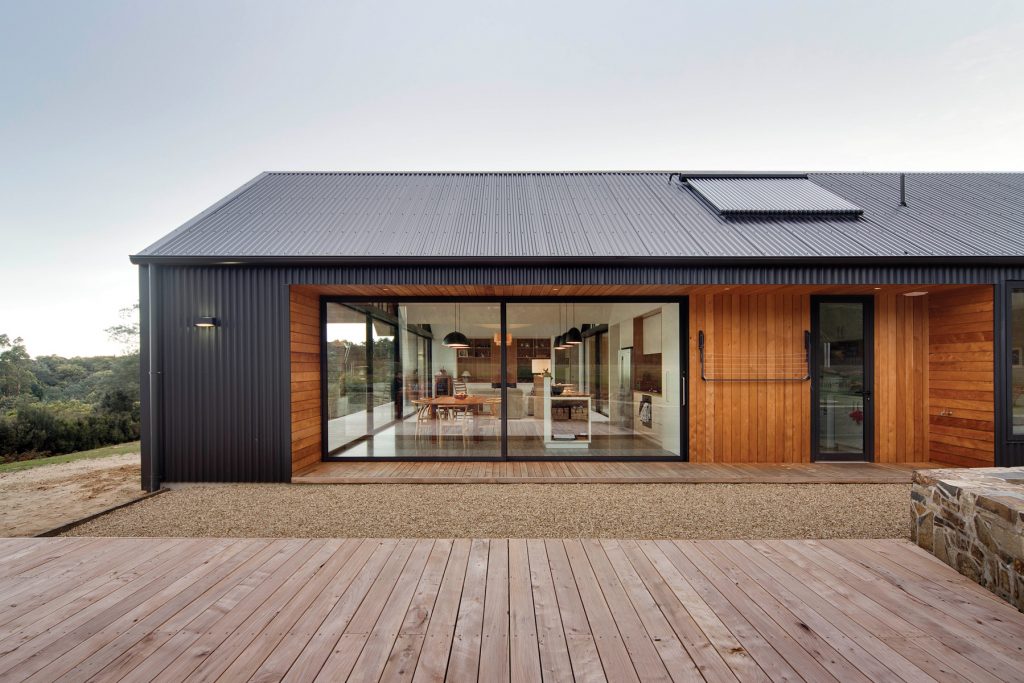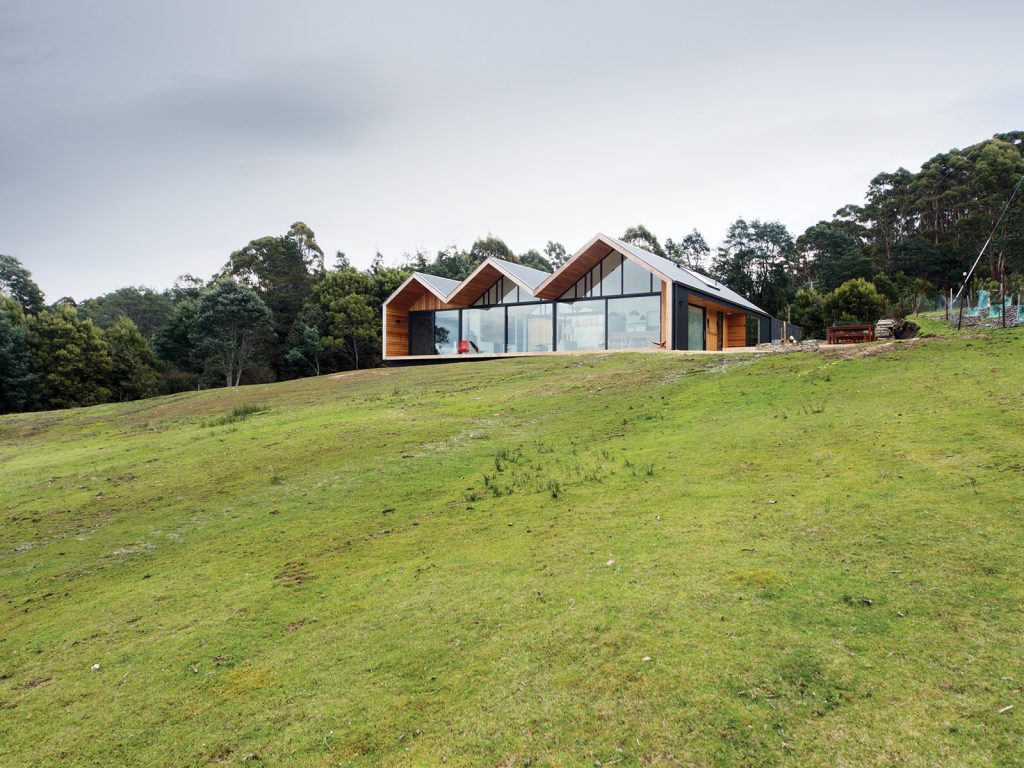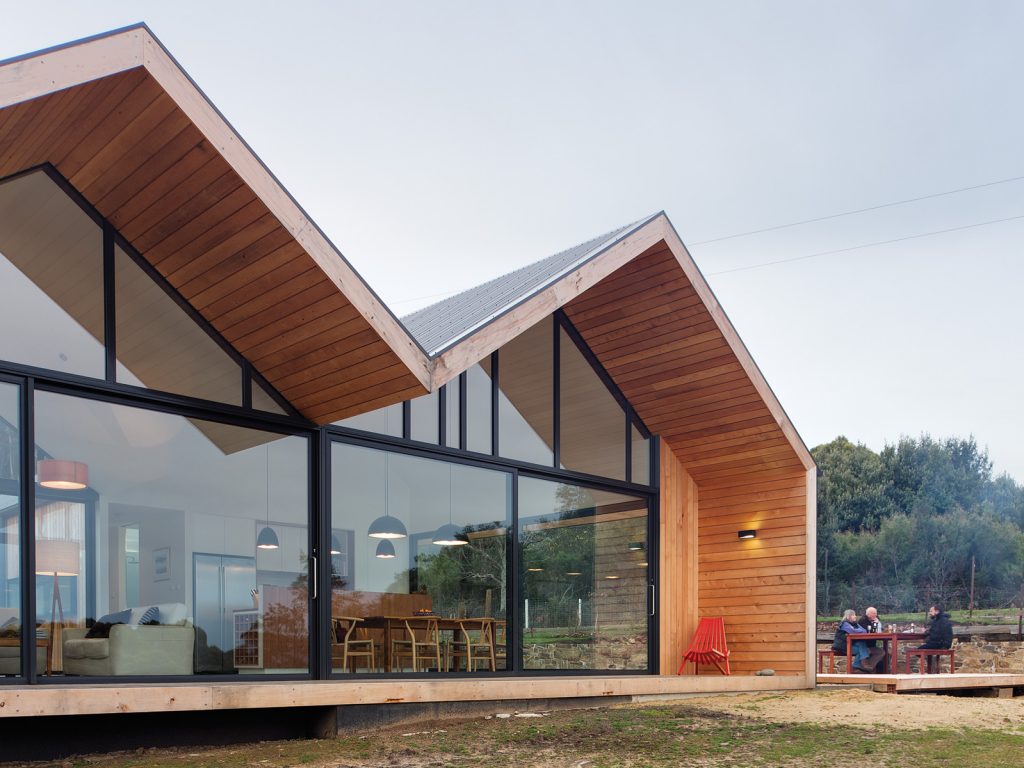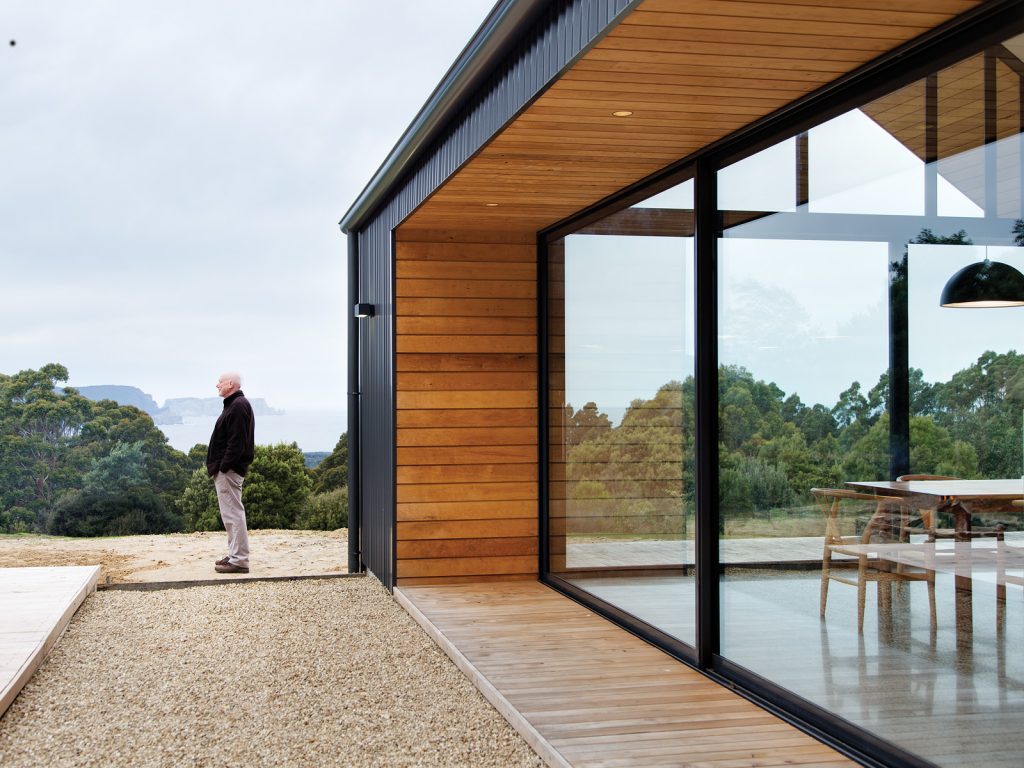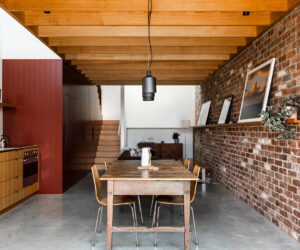Site Specific
With a superb site on the Tasman Peninsula, the owners put their trust in a firm of young architects. It was a leap of faith that led them in a direction they would never have thought of.
Elaine and Graham Speight weren’t intending to switch their urban existence for a rural one, but then they saw an exceptional block of land on the Tasman Peninsula. Their initial hope was to find land south of Hobart for camping, then they thought perhaps a holiday house, but ultimately this block proved irresistible.
“We lived in the northern suburbs of Hobart,” Elaine explains. “We thought we’d get some land and have it for camping. We liked this area and had been looking for about three years … Then we saw this block and we thought, why don’t we just retire down here? We had lived in country South Australia in the past, so 1.5 hours from Hobart seemed nothing.”
Not far from the island’s famed historic site of Port Arthur, the block has gun-barrel views to Tasman Island and the southern sea beyond.
The couple decided to engage an architect this time around, and because they planned to live on the land, and had not actually retired, they weren’t in a rush. So began a six-year conversation, still continuing, with family friend and architect Nathan Crump.
“They came to us because they knew the site was special and it needed some thought,” Nathan of the Hobart-based Room 11 explains. “They were newcomers to the whole architectural process … They took a leap of faith and they just said, ‘Don’t let it be like Grand Designs and go over budget!’”
The three principles of Room 11, at the time a newly founded firm, all came for the first visit. The siting of the house was obvious to both architects and clients. The land, a subdivision of farmland, had a natural flat and cleared area. It made sense to minimise their impact and to consider safety from bush fires; it also had the view of the wonderful blocky Tasman Island, and because the Speights had camped here, they knew the breezes. “And this is the only place on the land you can hear the sea,” Elaine says.
Next came the more challenging process of designing the house. Initially the client and architect came from very different starting points. The couple came with a scrapbook of eclectic ideas. Room 11 had already established a trademark modernist aesthetic. The owners wanted a farmhouse. Room 11 were interested in the typology of a courtyard house.
“A farmhouse wants to look out, wants to survey. In contrast, a courtyard house has an internal view,” Nathan reflects. “These two things are at odds.”
What Nathan and the owners evolved in their long conversations, undertaken both in person and in writing, was a way the two could work together. “The house is a hybrid of the typical rural farmhouse and courtyard house typology,” he says. “We are really interested in courtyard houses in Tasmania because of the weather … so we’ve got an introspective manicured landscape and we’ve got the contrasting wild landscape.”
Another innovation Room 11 developed was to explore the idea of the typical farmhouse as a series of buildings. “So here we used the roof gables to break down the bulk of the form and delineate the functions,” Nathan explains. “Also, this lets us present the view in different ways. The three gables or pitches give three individual framed views.”
When you first arrive at the house you are met by an elegantly spare timber façade protected by three overhanging gables. Clad entirely in celery top pine, it is interrupted only by a hexagon- shaped window, a request from Elaine, which gives visitors a hint of the view to come.
“You are given a blank façade. We take the view away,” Nathan says. “Then you step into the courtyard and there is the view. It is all about the extrusion of the section, [the gables] reinforce the gun-barrel view.”
Once in the front door, you look directly through the central courtyard. There is a traditional country mud room, with a seat for taking off shoes. From this delightful intimately-scaled space, you have a moment to take in a flood of natural light and outlook. “The courtyard brings sun into the depth of the plan,” Nathan says.
The walls either side of courtyard are solid, with just a slot window on the northern side. The bedrooms border the courtyard; the guest room with a big north-facing window and seat for extra sleeping is on one side, the owners’ bedroom, ensuite, walk-in wardrobe and study on the other.
“The gables help define the spaces in the house,” Nathan says. “This gable [defining the kitchen and dining] is the largest; then the next over [the living] is smaller and then the next is smaller again.”
The extrusion or continuation of the eaves also visually emphasises the outlook. The floor plan too is essentially governed by outlook and by orientation.
The kitchen and living room are located in the north-eastern corner, maximising northern sun. The kitchen dining area has glass sliding doors that open onto an outside eating area and a fire pit, all edged by a beautiful low stone wall, built by one of the stonemasons from the nearby Port Arthur site.
In terms of its passive solar design, the house has already proved itself. The outdoor eating area is popular and the fire pit, built by Graham from stones left over from the low wall, is a hit. The house itself is cosy. As well as capitalising on northern sun, it has a concrete slab which acts as a heat sink; its insulation and argon-filled double-glazed glass retain the warmth and its courtyard lets in the sunshine but protects from cold winds.
“We have spent our first winter here now,” Elaine says, “and even on the bitterest days, we didn’t turn on the heater until five o’clock at night.” They are happily looking forward to summer now, and how they will use the central courtyard to filter cooling breezes.
They love the house, even those aspects Nathan had to convince them about. Their builder too, reputedly a perfectionist, was also a success and is invited to the house-warming. And none of the horror stories they’d heard of budget blow-outs eventuated. What was once going to be a favourite spot for putting up their tent is happily now their permanent camp.
Specs
Architect
Room 11 Architects room11.com.au
Builder
South East Building southeastbuilding.com.au
Joiner
Farlow Joinery
Passive energy design
The modest (170m2) plan is arranged to maximise solar gain to the kitchen, dining and daybed while striking a balance with the views to the east. A courtyard punctures the building allowing for midday and afternoon sun to penetrate the depth of the plan. This courtyard creates a sunny and wind-sheltered outdoor space suitable for all seasons. Southern glazing to the study provides task appropriate daylighting, while a large skylight to the bathroom reduces the need for artificial lighting in the internal room. Operable glazing is carefully placed to make use of prevailing cooling breezes. In summer the external walls and courtyard glazing can be opened to flush excess heat.
Materials
The house is carefully sited on a gentle sloping hill, in a naturally occurring flat expanse, to minimise excavation and allow for a fully insulated slab on ground. This polished concrete slab provides thermal mass, stabilising natural ambient air temperature fluctuations. The roof and walls are highly insulated, lightweight timber construction. The exposed portions of the external skin are clad in dark-coloured Monoclad steel sheeting to absorb heat while inset walls, decks and soffits are lined in local celery top pine shiplap cladding. Protected by its own tannins and often used for boat building, the celery top pine is allowed to silver off naturally.
Flooring
Flooring is generally polished exposed aggregate concrete in high traffic areas and north-facing rooms for thermal mass. A light-coloured and textured high content wool blend carpet is used in remaining areas for warmth and comfort.
Insulation
The roof is insulated with high performance R3.8 glass wool bulk insulation as well as permastop insulated blanket sisalation. R2.5 glass wool bulk insulation and foil to walls, and the slab on ground is insulated with 50 mm R1.5 Styrofoam.
Glazing
All windows and doors are thermal break aluminium-framed sections with double glaze and argon fill. Insect screens allow large areas of natural cross ventilation throughout the day and across the seasons.
Heating and cooling
Passive solar design features including northern orientation, thermal mass, appropriate external shading and effective cross ventilation reduce the need for heating and cooling devices. In winter extra heat is provided by a gas fireplace and under tile heating. The central courtyard acts as a sun trap, allowing outdoor living year round.
Hot water system
30 Tube Apricus solar collector with electric boosted hot water cylinder. The pitch and orientation of the roof is designed to maximise the efficiency of the system.
Water tanks
Three above ground 10,000 L poly tanks provide all water needs for the house, garden and fire fighting.
Lighting
The house uses low energy and LED lighting from Casa Monde lighting. Pendants are used generally throughout to give an even efficient spread of light.

